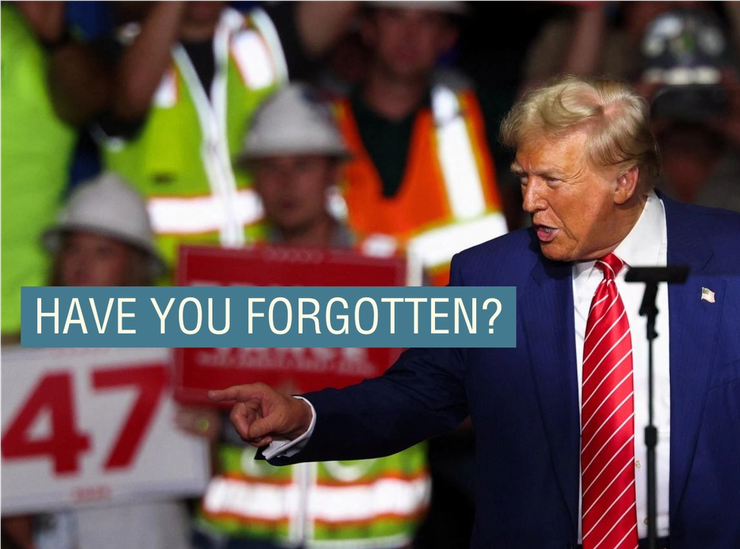The Scene
Forty-six days ago, Donald Trump made an unusual promise to the Republican National Convention. He would discuss his miraculous survival from an assassination attempt at a Pennsylvania rally. But only once.
“You’ll never hear it from me a second time,” Trump explained, still wearing a bandage on his left ear, where a bullet shot by 20-year old Thomas Crooks had hit him. “It’s actually too painful to tell.”
In the room, Republicans thought that the shooting had changed the trajectory of the race — an immutable image of Trump’s vigor and patriotism. In the weeks since, they’ve bristled at how quickly the national conversation moved on. Crooks’s own death on the scene, his ambiguous motive, and the swift resignation of the Secret Service director, had turned the story into a slow-moving procedural drama rather than a daily campaign story.
“We’re seven weeks away, and it’s as if it never happened,” former Trump aide Sebastian Gorka said at last weekend’s Moms for Liberty conference, when asked about “censorship” of the Butler shooting. “It’s been memory-holed, more effectively than George Orwell could ever have imagined.”
After the campaign resumed last month, Trump repeatedly invoked both the shooting and the idea that the media moved on too quickly. On Monday, he re-shared videos of the shooting and its aftermath, warning that “they want you to forget” what happened and “no one in government has been held accountable.” He wavered on the one-night-only pledge, telling interviewers like Phil McGraw about the Butler shooting and discussing whether God had saved him for a purpose.
“I think to a certain extent it’s Biden’s fault and Harris’s fault,” Trump told McGraw, who claimed without evidence that Democrats didn’t want him to get proper protection.
“I’ve learned a lot about weapons over the last six weeks,” he told attendees of the Moms for Liberty conference on Friday, after flying in from another Pennsylvania rally.
The conservative activists who laughed at that line hadn’t forgotten July 13. Ed Mackouse, a Moms for Liberty organizer in southeast Pennsylvania, had come to the conference wearing multiple homemade buttons, several using the AP’s photograph of Trump raising his fist and shouting “Fight!” while Secret Service agents swarmed him and blood ran from his ear. The image was everywhere at Trump rallies, sold on shirts and Christmas ornaments. Why had it faded on TV?
“The media is a business,” said Mackouse, explaining why images from July 13 weren’t appearing on TV very frequently. “They lie and do anything else to hurt Trump. They build up the Democrats, and they put him down.”
In this article:
David’s view
The shooting in Butler, which left one man dead and two more injured, made a hard initial impact on the presidential race.
It briefly paralyzed Democrats, who were lobbying Joe Biden to end his campaign. It sparked an important conversation between Robert F. Kennedy, Jr. and Trump, which led to Kennedy’s exit from the race. And it moved a few anti-Democratic Party figures to squarely support Trump; Elon Musk endorsed him and recommitted to a pro-Trump super PAC, and Nikki Haley got off the sidelines to support the nominee and speak at the RNC.
What it didn’t do was end the presidential campaign. Many panicky Democrats and confident Republicans thought that could happen, after seeing that Trump had been grazed by a bullet, gotten up, and pumped his fist.
“Let’s be honest: Trump just won,” Tucker Carlson said at a Heritage Foundation gathering on the RNC’s first day. “He stood up, faced the crowd, raised his hand, and said: ‘Fight, fight, fight.’ That’s it. You do that, you win.”
The punditry got ahead of the public — which, within days, was no longer choosing between Trump or Joe Biden. In polling averages collected by FiveThirtyEight, Trump’s personal favorable rating has risen three points since the shooting, from -12.2 to -9.5. That was dwarfed by the rise in Harris’s rating since she grabbed the Democratic nomination: -16.9 on the day of the shooting, -5.3 now.
No president had been hit by a would-be assassin’s bullet since 1981, and the well-remembered surge of public sympathy for Ronald Reagan shaped how the Butler shooting was covered. The Gallup Poll put Reagan’s approval rating at 60% before he was shot by John Hinckley, and 67% after. The boost only lasted two months, but it was real.
The Butler effect looks more like what happened in September 1975. Gerald Ford survived two assassination attempts as president, just weeks apart; once when Lynnette “Squeaky” Fromme failed to chamber a round before firing, once when Sara Jane Moore fired two rounds and missed. There was no meaningful impact on how voters viewed Ford. According to the Gallup Poll, his positive approval rating moved from 46% before the close calls, to 47% after.
That was in an unrecognizably slow media environment, and at a time of fairly low partisanship. There are no events anymore that break people out of their silos. When a Democratic strategist speculated that the Trump shooting might have been “staged,” he was humiliated and soon left his position with a top donor; he was also doing what Trump himself did in 2022, when his initial reaction to an attack on Nancy Pelosi’s husband was that it was fishy and politically convenient.
The View From Republicans
Their frustration has taken a few forms. Immediately after the shooting, a pause in partisan TV coverage and advertising seemed to augur a new and more respectful tone from the mainstream media and Democratic campaigns. It didn’t last, to the shock of pro-Trump Republicans.
“We are now on the third day of the DNC and still no mention of the fact that an assassin shot and nearly killed the opposition leader they’ve spent all week hysterically demonizing,” Stephen Miller wrote on X last month. In this weekend’s remarks at the Moms for Liberty conference, Gorka marveled at how multiple DNC speakers could call Trump an “existential threat” without worrying about the implications, like someone acting out to hurt him.
“The media doesn’t care, because they tried to kill him,” said Gorka. “Let’s be clear: It wasn’t one crazy 20-year old. They tried to kill him. That’s why they’re burying it.”
JD Vance has attributed the shooting not just to Crooks, but a generalized “them,” in a stump speech riff that implies a Democratic role in Butler, without getting specific. “They tried to put him in prison,” he’s said, “and they even tried to kill him.”
There are now two House investigations of the security failure in Butler — one launched by leadership with bipartisan support, and one by conservatives who question whether there was real malfeasance behind that failure.
Notable
- In the New York Times, Stuart A. Thompson and Tiffany Hsu see “a flurry of conspiracy theories” taking root on the left, including on Musk’s own website: “Mentions of the word ‘staged’ surged on X in the days after the shooting.”
- In ProPublica, a team of reporters study the Secret Service vulnerabilities revealed by Butler, where Trump intends to return before the election is over.


